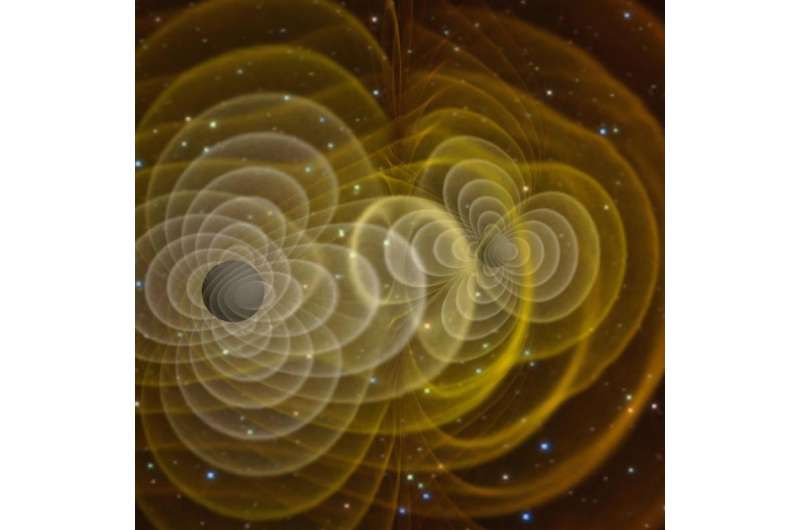Gravitational waves found, black-hole models led the way

Gravitational waves were predicted by Einstein's theory of general relativity in 1916, and now, almost exactly 100 years later, the faint ripples across space-time have been found. The advanced Laser Interferometric Gravitational-wave Observatory (aLIGO) has achieved the first direct measurement.
"We already have indirect evidence of gravitational wave emission from binary pulsars like the Hulse-Taylor system. But this aLIGO measurement provides the first direct detection and confirms what our modeling and simulation results have been suggesting - Einstein was right," said Christopher Fryer, Los Alamos National Laboratory Fellow and longtime researcher in this field.
"Working with experts in radiation transport and atomic physics in the Advanced Simulation and Computing program at Los Alamos, members of the theoretical astrophysics center are modeling this emission to compare theoretical models with direct observations," said Charlie McMillan, Los Alamos National Laboratory director. "This type of crosscutting capability is a hallmark of the national laboratory system and Los Alamos is gratified to have participated in a discovery of this magnitude."
A primary source of gravitational waves is a series of astronomical events called compact object mergers, involving the merger of binary systems consisting of neutron stars and/or black holes. "The actual observation was of a black-hole/black-hole merger. This proves aLIGO can detect these compact mergers. The detection process for neutron-star/neutron-star mergers is the same and our models predict both will occur. Observations of neutron-star/neutron star mergers will help us understand a great deal of physics and astronomy and the prospects for gravitational wave science are extremely exciting," said Fryer.
The electromagnetic follow-up, at Los Alamos and elsewhere, focuses on what we can learn from neutron-star/neutron-star mergers. It is this type of phenomenon that computer scientists, physicists and astronomy experts have been exploring, using computers to model the merger's many components to understand the basic physics more clearly.
aLIGO itself comprises a set of two widely separated interferometers—one in Hanford, Washington and the other in Livingston, Louisiana—that are operated in unison to detect the gravitational waves produced in the end-state of these merging systems. The facility's multi-kilometer-scale gravitational wave detectors use laser interferometry to measure the ripples in space-time caused by passing waves.
"Beyond the detection of gravitational waves, aLIGO provides a new window into studying astrophysical transients. Astronomers across the globe have been studying how aLIGO observations, coupled with telescopes from radio to gamma-rays, can be used to probe the extreme physics in these cosmic explosions," Fryer said.
"Even though the modeling and observations of these gravitational wave sources is difficult, requiring detailed, multi-physics models, the potential to study new realms of physics and understand new astrophysical transients is tremendous. Los Alamos is well-poised to solve these problems," Fryer said.
At Los Alamos National Laboratory's theoretical astrophysics center a broad effort has been underway, studying many aspects of these mergers from their progenitors (work led by former Oppenheimer Fellow Krzysztoff Belczynski) to their implications in helping scientists understand astrophysical transients and as probes of the physics of matter under extreme conditions.
"Our program studying merger progenitors argued that the most-likely system would be a binary black hole system," stated Fryer, "and it is gratifying to see that this first detection is exactly such a system. As aLIGO detects more of these mergers we will be able to probe aspects of stellar evolution."
Working with a team of experts from many areas of physics and astronomy, including dense nuclear matter, binary stellar evolution, gamma ray bursts and multi-physics computational modeling, Fryer has focused on determining what we can learn from these gravitational wave detections. The team uses a combination of Newtonian merger calculations, neutron star equation of state studies, and population synthesis simulation to model the outcome of the merger of the two neutron stars.
The researchers determined the statistical likelihood that the remnant from the merger
1) collapses directly to a black hole,
2) collapses to a black hole after a delay, or
3) remains a neutron star.
Whether the core is a black hole or neutron star depends on whether it is more massive than the maximum neutron star mass at its spin rate.
More information: Related papers:
Chris L. Fryer et al. THE FATE OF THE COMPACT REMNANT IN NEUTRON STAR MERGERS, The Astrophysical Journal (2015). DOI: 10.1088/0004-637X/812/1/24
adsabs.harvard.edu/abs/2015ApJ...806..263D
adsabs.harvard.edu/abs/2013ApJ...779...72D
Journal information: Astrophysical Journal
Provided by Los Alamos National Laboratory



















